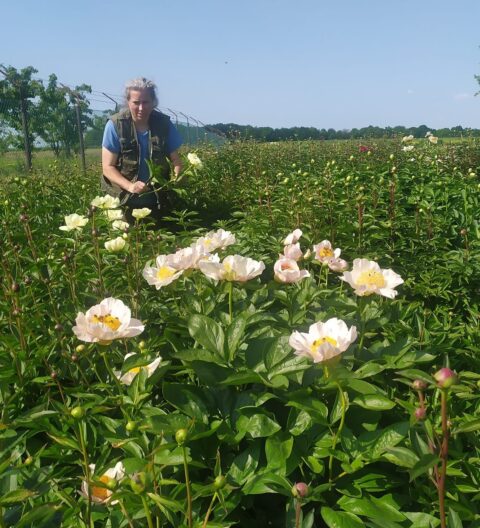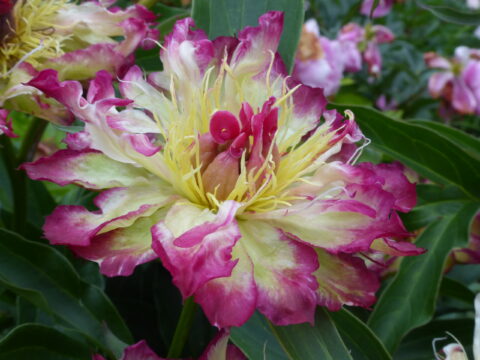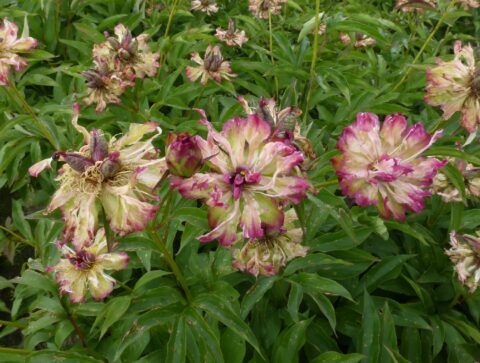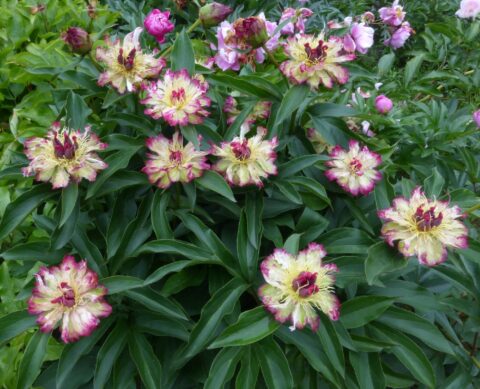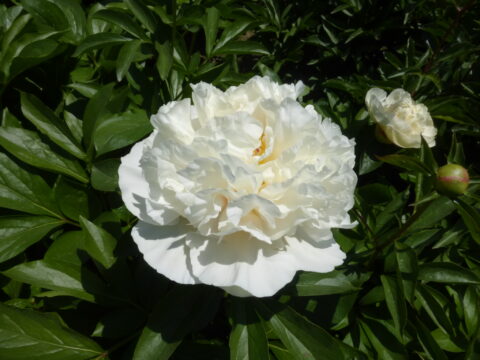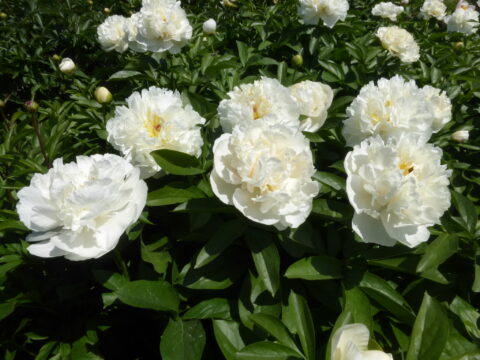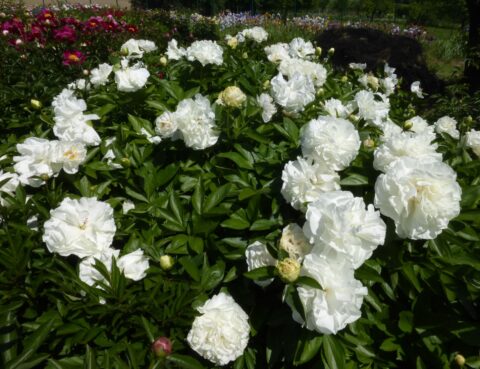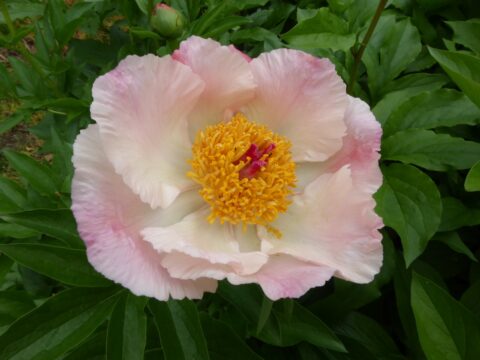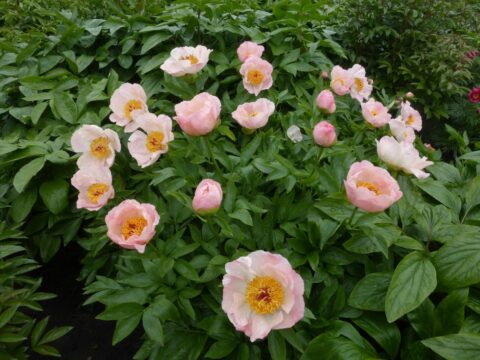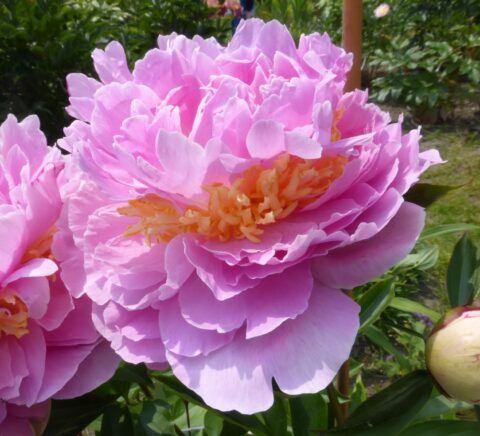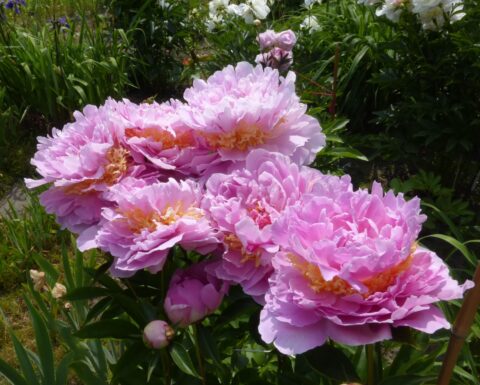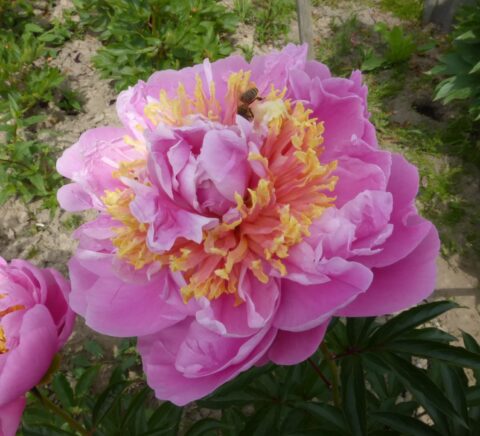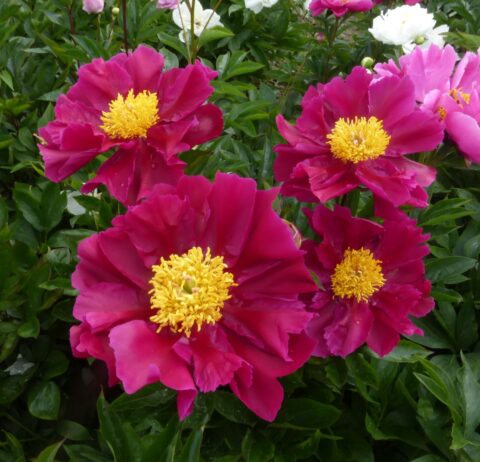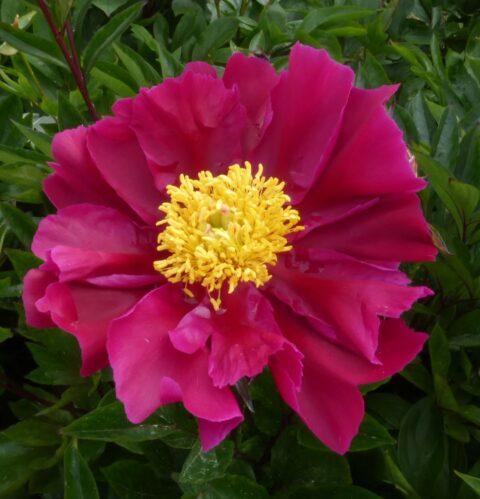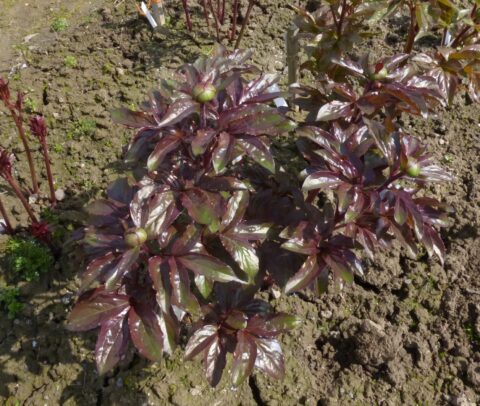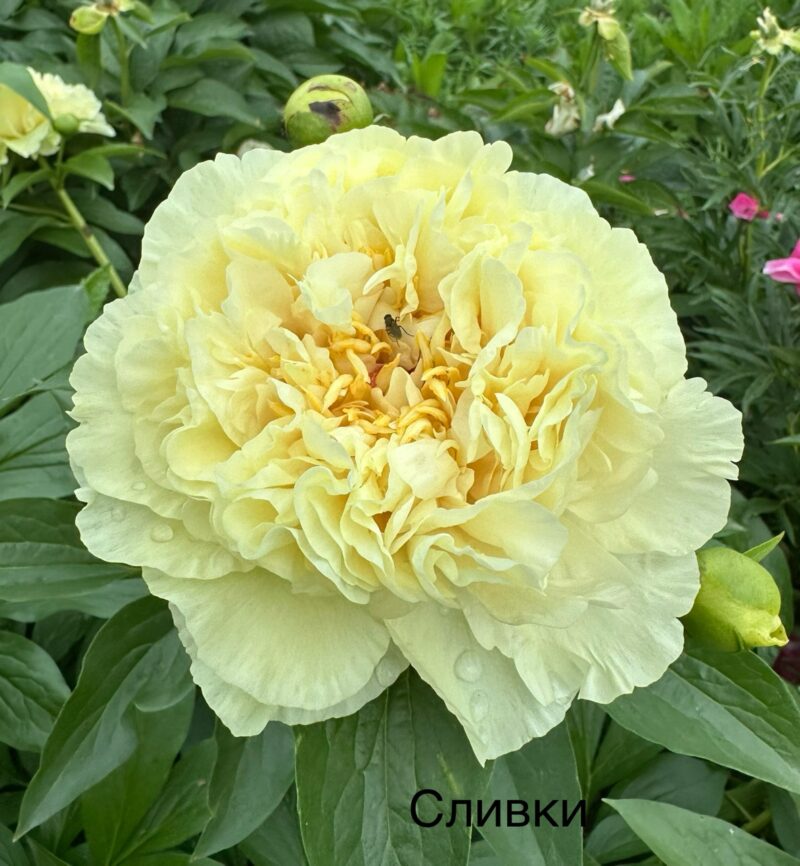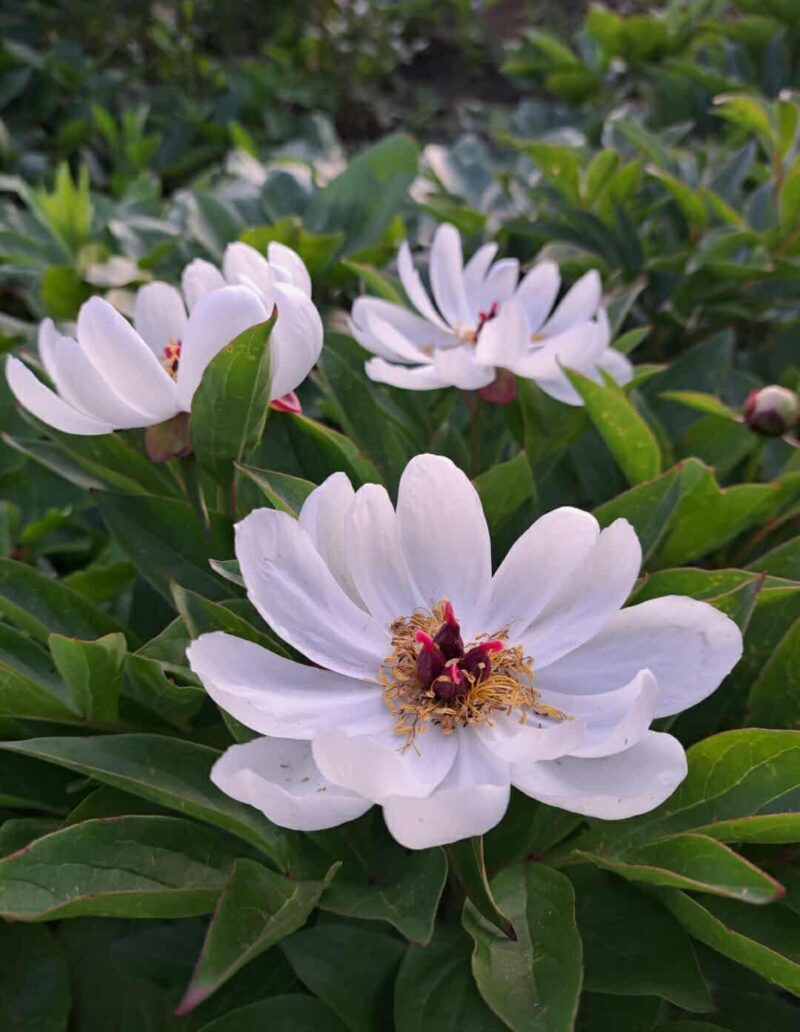Ewelina Wajgert
Country:
Poland
Short biography:
Married, 3 Sons, I’ve been growing flowers since I was a child, sharing my passion with my mother. I’m an electronics and telecommunications engineer by training. I worked professionally until the birth of my first child. Then, my career lost out to my passion for plants. It was similar for my mother, who is an economist by training.
More information:
http://waja.strefa.pl
https://www.facebook.com/ewelina.wajgert.9
How did you first get involved in peony hybridizing?
My mother, Stefania (she is also on the photos), started sowing her first peonies 20 years ago. She sowed them every year. Then we transplanted three- to four-year-old seedlings to provide them with the right conditions to produce full-fledged flowers. This is a long-term work, because after four years, there weren’t many flowering seedlings; only the seventh year brought results. Back then, during the flowering season, I was responsible for selection, and it consumed all my free time. In Poland, the internet was still in its infancy. There was no way to present flowers online. We hadn’t heard of APS either. And the only way to buy new varieties was from foreign nurseries. Our first peonies came mainly from Feldweber (Austria), Klose (Germany), and Kenneth Clare (Canada). These nurseries had a huge selection of peonies with lots of interesting varieties, but the seedlings weren’t large. We always bought one at a time—a couple for my mother, a couple for me. All our peonies we have were propagated from a single seedling. We noticed that new shapes and colors could be achieved from seed. Over time, our material became increasingly interesting and rich. As the internet developed, I showcased our seedlings on our website, and this sparked interest among our customers.
What was your starting material for your hybridizing?
From the aforementioned nurseries, we collected about 100 different varieties. We were very impressed by Sunny Girl, Miss America, Roy Person Best Yellow, Vanilla Raspberry Swirl, and Big Boy. Hogarth was beautiful. Initially, we mainly collected seeds from these peonies. Salmon Glory was incredibly impressive; it was a peony that changed colors, and we always looked forward to its blooms, even though it’s completely useless for hybridization.
What are your goals in hybridizing peonies?
We only work with the herbaceous peony. I must emphasize that we are still collectors, so it’s important to us that our peonies bloom for a very long time. We also create with our Polish and European collectors in mind, who need plants for their home gardens, and this is our priority. We always ask ourselves what we like, regardless of wholesale market needs or trends. If we like a particular hybrid, there’s a high probability that others will too. We pay attention to resistance to various pests, but our peony doesn’t necessarily have to multiply quickly. The entire process—sowing, waiting for the first blooms, working on their inventory, selecting, propagating, and presenting the results—is meant to be a wonderful experience. Of course, we pay attention to flower shape, height, and fragrance, and try to select representatives from all groups. Because just because something looks beautiful doesn’t mean it has to have a fragrance. That’s why I constantly strive to record as much information as possible about our peonies, so that anyone deciding on a specific variety knows as much as possible about it, and if a particular characteristic is a hindrance, they can forgo it. I try to avoid peonies that are very tall, 130-150 cm. Despite their stiff stems, they usually always require support, even when it’s not raining. I love early hybrids – our Miss Polonia, Cortina, Vanilla Cream, and Spring Sensation are admired by collectors. I love Japanese peonies, but I give others a chance than those already on the market, and Spaghetti has been successful in this regard. My latest challenge, however, is peonies with a wreath of staminodes between the petals, and those that tend to bloom later in the season. The first registrations from this group have already been submitted, but I’m still trying to find plants with better characteristics. Their flowers are usually heavier and require mechanical support. I’ve made a few selections, but registration is still a long way off.
Do you mostly depend on open pollination or do you mostly make controlled crosses?
| 100% open | 50/50 | 100% controlled |
How large is your hybridizing program?
We never count seeds; we definitely try to sow the more interesting ones; there are about a thousand of them a year. We sow a lot of them because it allows us to select something interesting. After four years, when the first ones bloom (about 5%), I make my first selection, and I wait for the rest in subsequent years. I photograph about 500 seedlings each year, both new and older, those that have been under observation for a while, but I also photograph varieties that have been around for decades. I do this throughout the growing season, not just during flowering. It’s a very exciting but time-consuming activity, especially since the peonies are labeled and pre-selected at the same time. I estimate my collection at around 3,000.
Do you have any plants in the market?
Yes, I sell surplus plants. Besides peonies, I’m also passionate about Irises (I have 600 varieties), Hepatica, and other perennials. My offerings are always available on my website http://waja.strefa.pl and on Facebook. I always do this myself, because in addition to selling, I also advise clients on which varieties will best meet their needs. I also enjoy establishing direct contact with my clients, and with some of them I create bonds that last for years.
Can you describe a few of your plants that you consider the best or most beautiful and which are available now?
The problem is finding my varieties that meet all these criteria 🙂 It’s the end of the season (late October). The varieties I registered are very popular. Even those available in larger quantities sold out very quickly, and some didn’t even make it into the offer. But if I had to find something for someone at this time, it would be Spring Sensation, which is our earliest hybrid. It grows well, so it wouldn’t be a problem to deplete my stock. It’s not very tall, and its flowers are large, reaching up to 18 cm in diameter, apricot-peach with pink blush. It also has attractive leaves – smaller than most hybrids. In my opinion, it’s the most beautiful single-flowered peony in our garden. Another one that could be considered is Bird of Paradise. It divides quite well, grows nicely, is a late bloomer, and decorates the garden for a long time. The flowers are small, but numerous. An additional decorative feature are the red pistils and stigmas. The petals last a very long time, and the flowering process doesn’t disfigure the plant. If anyone needs a hybrid, I could also suggest Cortina. It’s a wonderful semi-double variety, registered in 2023. It has stiff stems, doesn’t require mechanical support, and the flowers are ecru. Its distinctive feature is that it blooms between early and mid-season peonies. Few varieties bloom at this time. It pairs beautifully with Jewel. They bloom simultaneously, and it retains its green foliage until the end of the season. The problem for us is that both my mother and I work together. Therefore, we have limited time and space. We can’t produce more because we won’t be able to handle it. We treat new registrations more as a thank you to our existing customers for their interest in a given hybrid. If collectors like one of them and we receive more inquiries each year than we can sell, it confirms that we made the right choices. If something isn’t generating interest, even though it has good features and was selected by me, it must wait for a better time or be reduced. Such are the laws of the market.
In the coming years, we will definitely be propagating our newly registered varieties. This year, we divided Miss Polonia, which is in very high demand not only in Poland but also abroad. It’s a hybrid, reaching around 110 cm. It’s very striking – green buds turn beige, and the final color of the fully developed plant is powdery pink. The flowers are massive. Even though it was growing at the back of my garden, it attracted walkers from the sidewalk.
We’re also definitely waiting for our varieties that change color during flowering to be reborn. It’s a very interesting phenomenon. They start pink (Fabulous Journey and Fabulous World) and finish almost white with a pink spot in the center. However, the color of Color Carousel is completely different. The most interesting case I’ve observed is that half the flower is pink and half is light. They’re not very late bloomers, so they usually manage to change before the heat of summer begins.
Mint Delight is also a record-breaking variety among our varieties. This is our latest variety, capable of blooming even in early July, when the season is normal. It has green buds, and the greenery persists in places even after opening. The fully opened flower is dotted with pink, while the background is ecru.
The collector market has given our first Polish registrations a very positive review, which is very motivating for further work. Each year, we strive to divide as many of our varieties as possible with a view to offering them in future years, but we also want to maintain a wide variety of plants so as not to lose the collectible character of our collection.
Within your current seedlings, what are the most promising ones?
As for those that haven’t been registered yet, there’s definitely E044, which is pink with a golden wreath of staminodes, and SL403, a dark cherry, semi-double with a silver edge. I’d really like people to also love single-flowered peonies. People don’t know them at all or dismiss them for various reasons. Collectors are particularly drawn to SA057 and FC058. These four are already being propagated, but there are many promising ones that will be added to the collection in the coming years.
Are you in contact or working together with other peony hybridizers?
I love observing the varieties others create, reading their descriptions, and sometimes we contact them via Facebook. However, face-to-face contact is difficult because everything is so far away. Our peonies, however, are the first Polish peonies to be registered. When the news of the registrations spread, it was an incredible event. Everyone was delighted that Poland had its own peonies, and such an original collection at that, and congratulations poured in from all over the world. I think it was a moment when we were noticed and our efforts were appreciated. I particularly value our collaboration with the Wojsławice Arboretum, which houses the National Collection of Peonies, and since 2025, my varieties have also joined this collection.
Do you have unregistered plants that are not good enough to introduce but have something ‘special’?
I think I would need to have much more knowledge to answer this question.
Would you like to exchange such ‘hybridizers plants’ with other hybridizers?
There are many beautiful new peonies. I’m currently expanding my collection with only unique specimens due to lack of space. However, I’d love to recommend them to other new gardeners so I can see something different in their gardens than I do in my own garden.
Do you know the American Peony Society (APS)? Are some of your plants registered with them? Do you have any suggestions?
Yes, I am a member. I have registered 16 varietes and I submitted another one for registration.
I believe the database of registered peonies should be expanded above all. A single photo in the database is definitely not enough. Peonies are variable and behave differently depending on temperature and soil. Of course, these photos must come from a reliable source, preferably from a breeder. I share several photos at different stages of growth, and they should be included in the database. A database with limited information is not a good source of information, and my colleagues and I frequently consult it, pointing out to newcomers where they can find information. Descriptions and photos of older varieties, especially those currently available for sale, should also be gradually updated.
I have reservations about the registration process during the season. Our Polish variety “Nasz Wrocław” was entered into the register, but without a description or photos. This was very important to us because it was supposed to be presented at the conference. Several other varieties were also entered. This is not good, because we want to enjoy full registration. If there’s no time during the season to finish the work we started, we can actually continue it in winter as it was. Such incomplete work is like a mess. The international community is watching this, and APS, as a serious organization, should take care of its good image.
It would be great if APS created a subpage with profiles of breeders, not just American ones. So that some trace of us remains. Look what’s happening – two powerful growers/brokers from whom I got my peonies: Klose (Germany) and Kenneth Clare (Canada). I used to go to Klose myself. Now they’ve disappeared from the peony scene. There’s a lot of talk about Gorobetz these days in Poland and Ukraine. It would be good to have such information on such an important site as the APS website.
Name a few peony varieties from other hybridizers which you especially like?
Walküre (Miely) definitely catches my eye every time; it has stiff stems and a beautiful habit. I’m absolutely thrilled with Hans Machke’s achievement and its double pink tenuifolia. Among the very old varieties, I love Miss America with its big snow-white flowers, with double blooms from side buds. I could go on and on, but if I’ve had about 100 varieties for over 20 years and keep dividing them, I guess it means each one has something special. 🙂
Final question. Any remarks or suggestions you may have…
Expanding APS’s activities beyond the United States. APS brings together people from all over the world, so it should reach out to them with suggestions. We can only hope that this survey is the first step in this direction. Regarding the website, it would be nice to see more publicly available scientific publications written by competent people. There are so many hybridizers and people involved in peony research, yet very few share their knowledge.
E-mail of this person is known to the author. If you want to contact this hybridizer, we can forward your message.
